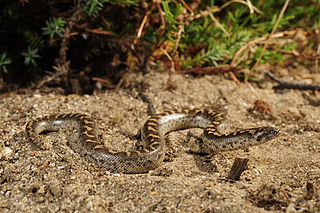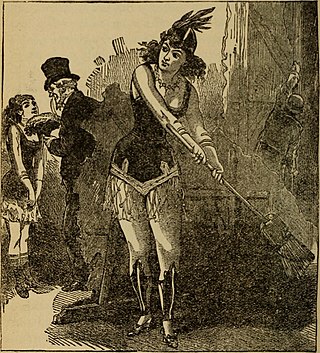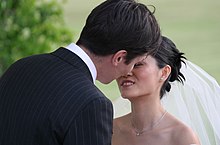
Sexual attraction is attraction on the basis of sexual desire or the quality of arousing such interest. Sexual attractiveness or sex appeal is an individual's ability to attract other people sexually, and is a factor in sexual selection or mate choice. The attraction can be to the physical or other qualities or traits of a person, or to such qualities in the context where they appear. The attraction may be to a person's aesthetics, movements, voice, or smell, among other things. The attraction may be enhanced by a person's adornments, clothing, perfume or hair style. It can be influenced by individual genetic, psychological, or cultural factors, or to other, more amorphous qualities. Sexual attraction is also a response to another person that depends on a combination of the person possessing the traits and on the criteria of the person who is attracted.

In sexuality, seduction means enticing to sexual intercourse.
Sociosexuality, sometimes called sociosexual orientation, is the individual difference in the willingness to engage in sexual activity outside of a committed relationship. Individuals who are more restricted sociosexually are less willing to engage in casual sex; they prefer greater love, commitment and emotional closeness before having sex with romantic partners. Individuals who are more unrestricted sociosexually are more willing to have casual sex and are more comfortable engaging in sex without love, commitment or closeness.

Physical attractiveness is the degree to which a person's physical features are considered aesthetically pleasing or beautiful. The term often implies sexual attractiveness or desirability, but can also be distinct from either. There are many factors which influence one person's attraction to another, with physical aspects being one of them. Physical attraction itself includes universal perceptions common to all human cultures such as facial symmetry, sociocultural dependent attributes, and personal preferences unique to a particular individual.

David Michael Buss is an American evolutionary psychologist at the University of Texas at Austin, researching human sex differences in mate selection. He is considered one of the founders of evolutionary psychology.

Parental investment, in evolutionary biology and evolutionary psychology, is any parental expenditure that benefits offspring. Parental investment may be performed by both males and females, females alone or males alone. Care can be provided at any stage of the offspring's life, from pre-natal to post-natal.

A psychological adaptation is a functional, cognitive or behavioral trait that benefits an organism in its environment. Psychological adaptations fall under the scope of evolved psychological mechanisms (EPMs), however, EPMs refer to a less restricted set. Psychological adaptations include only the functional traits that increase the fitness of an organism, while EPMs refer to any psychological mechanism that developed through the processes of evolution. These additional EPMs are the by-product traits of a species’ evolutionary development, as well as the vestigial traits that no longer benefit the species’ fitness. It can be difficult to tell whether a trait is vestigial or not, so some literature is more lenient and refers to vestigial traits as adaptations, even though they may no longer have adaptive functionality. For example, xenophobic attitudes and behaviors, some have claimed, appear to have certain EPM influences relating to disease aversion, however, in many environments these behaviors will have a detrimental effect on a person's fitness. The principles of psychological adaptation rely on Darwin's theory of evolution and are important to the fields of evolutionary psychology, biology, and cognitive science.

Sexual jealousy is a special form of jealousy in sexual relationships, based on suspected or imminent sexual infidelity. The concept is studied in the field of evolutionary psychology.

The waist–hip ratio or waist-to-hip ratio (WHR) is the dimensionless ratio of the circumference of the waist to that of the hips. This is calculated as waist measurement divided by hip measurement. For example, a person with a 75 cm waist and 95 cm hips has WHR of about 0.79.
Human male sexuality encompasses a wide variety of feelings and behaviors. Men's feelings of attraction may be caused by various physical and social traits of their potential partner. Men's sexual behavior can be affected by many factors, including evolved predispositions, individual personality, upbringing, and culture. While most men are heterosexual, there are minorities of homosexual or varying degrees of bisexual men.

Mate choice is one of the primary mechanisms under which evolution can occur. It is characterized by a "selective response by animals to particular stimuli" which can be observed as behavior. In other words, before an animal engages with a potential mate, they first evaluate various aspects of that mate which are indicative of quality—such as the resources or phenotypes they have—and evaluate whether or not those particular trait(s) are somehow beneficial to them. The evaluation will then incur a response of some sort.

Sexual selection in humans concerns the concept of sexual selection, introduced by Charles Darwin as an element of his theory of natural selection, as it affects humans. Sexual selection is a biological way one sex chooses a mate for the best reproductive success. Most compete with others of the same sex for the best mate to contribute their genome for future generations. This has shaped human evolution for many years, but reasons why humans choose their mates are not fully understood. Sexual selection is quite different in non-human animals than humans as they feel more of the evolutionary pressures to reproduce and can easily reject a mate. The role of sexual selection in human evolution has not been firmly established although neoteny has been cited as being caused by human sexual selection. It has been suggested that sexual selection played a part in the evolution of the anatomically modern human brain, i.e. the structures responsible for social intelligence underwent positive selection as a sexual ornamentation to be used in courtship rather than for survival itself, and that it has developed in ways outlined by Ronald Fisher in the Fisherian runaway model. Fisher also stated that the development of sexual selection was "more favourable" in humans.
In sexual relationships, concepts of age disparity, including what defines an age disparity, have developed over time and vary among societies. Differences in age preferences for mates can stem from partner availability, gender roles, and evolutionary mating strategies, and age preferences in sexual partners may vary cross-culturally. There are also social theories for age differences in relationships as well as suggested reasons for 'alternative' age-hypogamous relationships. Age-disparate relationships have been documented for most of recorded history and have been regarded with a wide range of attitudes dependent on sociocultural norms and legal systems.
Douglas T. Kenrick is professor of psychology at Arizona State University. His research and writing integrate three scientific syntheses of the last few decades: evolutionary psychology, cognitive science, and dynamical systems theory. He is author of over 170 scientific articles, books, and book chapters, the majority applying evolutionary ideas to human cognition and behavior.

In evolutionary psychology and behavioral ecology, human mating strategies are a set of behaviors used by individuals to select, attract, and retain mates. Mating strategies overlap with reproductive strategies, which encompass a broader set of behaviors involving the timing of reproduction and the trade-off between quantity and quality of offspring.

Gynoid fat is the body fat that forms around the hips, breasts, and thighs. Gynoid fat in females is used to provide nourishment for offspring, and is often referred to as 'reproductive fat'. This is because it contains long-chain polyunsaturated fatty acids (PUFAs), which are important in the development of fetuses. It is regarded as a physically attractive feature, serving as an indication towards a woman's reproductive potential.
Mate value is derived from Charles Darwin's theory of evolution and sexual selection, as well as the social exchange theory of relationships. Mate value is defined as the sum of traits that are perceived as desirable, representing genetic quality and/or fitness, an indication of a potential mate's reproductive success. Based on mate desirability and mate preference, mate value underpins mate selection and the formation of romantic relationships.
Female intrasexual competition is competition between women over a potential mate. Such competition might include self-promotion, derogation of other women, and direct and indirect aggression toward other women. Factors that influence female intrasexual competition include the genetic quality of available mates, hormone levels, and interpersonal dynamics.

Human mate guarding refers to behaviours employed by both males and females with the aim of maintaining reproductive opportunities and sexual access to a mate. It involves discouraging the current mate from abandoning the relationship whilst also warding off intrasexual rivals. It has been observed in many non-human animals, as well as humans. Sexual jealousy is a prime example of mate guarding behaviour. Both males and females use different strategies to retain a mate and there is evidence that suggests resistance to mate guarding also exists.
In humans, males and females differ in their strategies to acquire mates and focus on certain qualities. There are two main categories of strategies that both sexes utilize: short-term and long-term. Human mate choice, an aspect of sexual selection in humans, depends on a variety of factors, such as ecology, demography, access to resources, rank/social standing, genes, and parasite stress.














